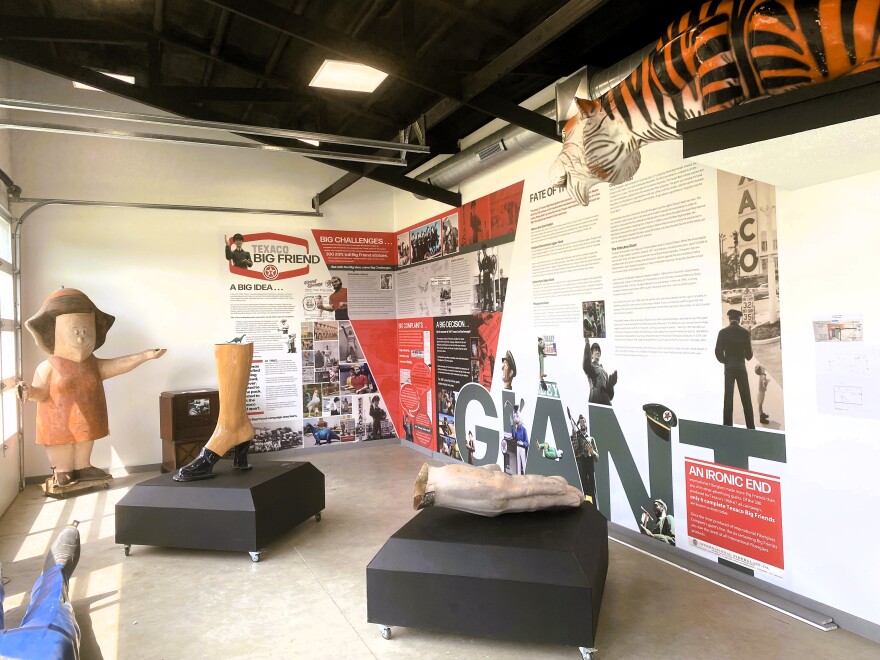Atlanta, Illinois, is perhaps best known for two photo ops. There’s the Logan County city’s banana-hued, smiley-faced water tower. The other? A giant statue of “Paul Bunyon” with a hot dog that sits right in the center of town.
While these are prime reasons to drive through Atlanta while navigating the Mother Road, city officials are rapidly adding reasons to stay awhile.
A new exhibit opened last month on the grounds of the J.H. Hawes grain elevator that marks Atlanta’s four-decade failed attempt at erecting a functional coal mine beginning in the late 19th century.
“They knew there was coal beneath this community, they just hadn’t dug it up yet,” said Bill Thomas of the Atlanta Betterment Fund.
Wyoming and Appalachia are more well known for their supplies of black gold, but Illinois also is coal country. The first coal in North America was discovered in Illinois, which is how we get communities named Coal City. Or Carbondale.
Thomas said citizens of Atlanta were relying on supplies from other towns in coal-rich Logan County. Fewer than 2,000 miners work underground in Illinois today, a drop of 80% since the 1980s. But the coal industry is still central to the identities and economies of several Illinois counties.
“In the late 1870s, a group of gentlemen in town got together and formed a coal company,” he said. The group raised money and started digging, but repeatedly hit water.
“They brought in huge pumps from St. Louis and tried desperately to pump the water out,” Thomas said. After four attempts, between 1915 and 1920, the town took a lemons-to-lemonade approach, using the water source to hydrate Atlanta.
It took several years to retrofit the existing mine shaft with a viewing window and lights that illuminate the crevasse all the way to the bottom that is still filled with potable water. The project was largely shepherded by Atlanta’s longtime city clerk Ken Martin, who died in 2021. The museum paid homage to Martin by naming a bench in his honor.
The Atlanta Coal Mining Company Historical Mine is part of a three-tiered approach to ramp up tourism in Atlanta as the city looks to capitalize on visitors approaching the 2026 Route 66 Centennial.
“We incorporated this coal mine into part of our historic exhibit here next to the elevator and carriage house, along with our library,” said Mayor Adam McVey. “Then we have the tourism option for our local community with golfing (and) with the baseball fields. The third piece of that is Route 66.”
“It’s a multi-faceted approach that gives a person a reason to come to Atlanta and spend half a day here,” McVey said.
In other words, rolling up to Paul Bunyon and snapping a photo doesn’t always give folks a reason to spend money. By creating more points of engagement, local restaurants, gas stations, souvenir shops and hotels can benefit from tourists itching to spend money.
Case in point: On a single morning in early June, more than 50 Route 66 fans came through the Atlanta Coal Mining Company exhibit. One visitor offered to buy the baseball cap off tourism director Scott McCoy’s head.
“They came here specifically because they heard of (the mine) as part of Atlanta’s attractions and museums,” McCoy said.

American Giants Museum to open in July
There are more attractions on the way. The forthcoming American Giants Museum sits at the corner of Arch and Vine, across the street from Chubby’s Bar and Grill and just a few paces from that hot dog-toting Paul Bunyan.
The museum, set to open next month, has the façade of an old Texaco station, and will feature the world’s largest collection of enormous fiberglass figures created as roadside advertisements in the 1960s.

The American Giants Museum will house Joel Baker’s collection of American giants, including a 24-foot-tall Texaco man.
“(Texaco) had 300 initially built,” said Thomas. “They rolled out the campaign across the nation and it was an absolute logistical nightmare. …The campaign lasted a year, then Texaco said, destroy all 300. Six survived and we will get one of the six.”
The Atlanta Coal Mining Company Historical Mine, 204 SW 1st Street, Atlanta, is free and open to the public. The American Giants Museum, 100 NW Arch St., is scheduled for a soft opening in July. Admission will be free.






